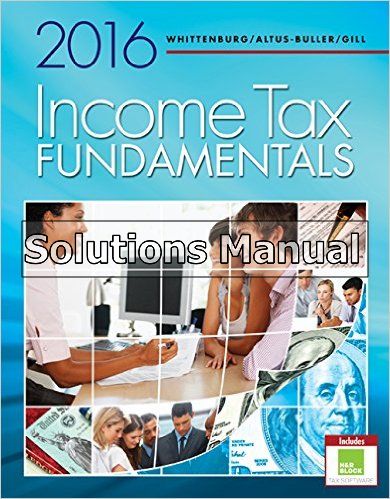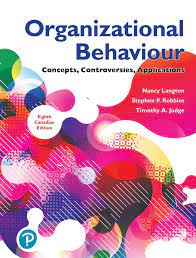
Test Bank For Income Tax Fundamentals 2016 34th Edition
Original price was: $75.00.$28.00Current price is: $28.00.
Test Bank For Income Tax Fundamentals 2016 34th Edition provides comprehensive coverage of tax laws and regulations. The Test Bank helps readers learn and understand the tax code, as well as how to prepare accurate tax returns.In addition, the Test Bank includes practice questions and answers to help reader Test their knowledge of the material. The Test Bank For Income Tax Fundamentals 2016 34th Edition is an essential resource for anyone who needs to master the tax code.
Are you currently enrolled in the Income Tax Fundamentals course and trying to prepare for the exam? There is indeed so much information to cover! You are not alone! We have all been there. The 2016 34th Edition of Income Tax Fundamentals written by Gerald E. Whittenburg is a great textbook, but most of the time you need a little more than what it offers for full mastery. That’s where our Test Bank comes into play!
Consider our test bank as your backup. It’s a collection of practice questions that cover everything from basic tax concepts to complex tax calculations. This means you can test your knowledge, practice answering different types of questions, and see what you need to study more. It is really like carrying around a small test in your back pocket!
Why Should I Use This Test Bank?
Think about coding for a second, you are going to college and studying for your complicated exam and you run into a question that seems complicated, There are several things that you can do for it, one of which is learning for example, grabbing your college textbook and attempting to flip through multiple pages, or theory – explaining the whole concept and why it was built the way it is. But if you have our test bank with you, you can look up a similar question on the bank and check how it’s answered step by step. A test bank allows you to do such things as:
- Make sure to practice all question types: There will also be practice true or false questions along with multiple choice questions and fill-in-the-blank questions just as is the case with your real exam.
- Overcome the fear of failure: As you keep practicing, you will feel more and more confident concerning the exam.
Key Topics Covered in Our Test Bank
All of the key issues that you would be required to know and understand in taking the Income Tax Fundamentals examination are:
- Company taxation:- an overview
- What is Taxation? Another area of interest is how taxes came into being, what kinds of taxes people pay, and how taxes are deployed. For instance, there relation numerous questions that stem from the differences between federal state, and local taxation.
- Tax Law and its Application: You will get acquainted with the various levels of government that play a role in taxation together with the Internal Revenue Service IRS and how tax laws are formulated. Possibly you will need to respond to how the IRS can enforce tax collection and how tax laws have been altered.
- Income Tax from Individual
- Income and Deductions: You will perform estimations on taxable income and the computation of various deductions. For instance, in this case, you may need to determine your taxable income from salary, interest income, and, dividends. In addition, there will be other categories of deductions such as medical expenses, home mortgage interests, and even charitable contributions.
- Credits: You will be asked how to claim various credits which aim at reducing tax liability. Examples may include the Earned Income Tax Credit, the Child Tax Credit, and the American Opportunity Tax Credit.
- Taxation of Business Income
- Sole Proprietorships and Partnerships: Possibilities would like to calculate the respective taxes for businesses organized as sole proprietorships or partnerships and self-employed persons such as sole proprietorships and partnerships. In this case, you may be asked to compute tax liability for a business run as either a sole proprietor or as a partner in a partnership business.
- Corporations: During this unit, you will get familiarized with the various classifications of corporations together with the applicable taxes. Laws concerning C corporations, S corporations, and limited liability companies (LLCs) will have to be emphasized.
- Property Taxation
- Real Estate and Personal Property: Taxation on real estate and personal property will be taken into consideration at this point. You should know how to determine a lot’s or a vehicle’s property tax.
- Sales and Use Tax
- Sales Tax and Use Tax: Questions dealing with sales tax and the context in which use tax is applicable will be seen. For instance, it is possible that you will be asked to compute the sales tax on an item that you bought or whether a use tax is payable on merchandise bought online from overseas.
- Other Taxes
- Estate and Gift Taxes: You will also learn how to compute taxes under an estate on properties that have been inherited and gifts receivable. For example, how much estate tax would you expect to pay on an inheritance or how much gift tax would you have to pay for the numerous gifts that you got?
- Payroll Taxes: Taxes withheld from employees’ wages and those paid by employers will be looked at in detail. The major focus areas will include Social Security tax, Medicare tax, and unemployment tax.
Advantages Of Our Test Bank
- Dull Lessons Are A Thing Of The Past: The practice questions located in our test bank help you remember the concepts more effectively.
- Perfection At Its Best: As the popular saying goes, practice makes perfect! With our test bank, there’s no question on your exam paper you cannot handle.
- Convenient: After using our test bank, you will be able to determine your areas of strengths and weaknesses easily to polish your skills and knowledge further.
- Cheap And Affordable: Our test bank is nowhere near as expensive as the other alternatives.
Summary
Using our test bank for Income Tax Fundamentals should lead you to success. Since it covers all vital broad areas, you will also be able to prepare yourself thoroughly for the needed exam and the subject of taxation in general!
Test Bank For Income Tax Fundamentals 2016 34th Edition
Chapter 6 — Credits and Special Taxes
1. What would reduce income taxes more: a $100 tax credit or a $100 tax deduction?
ANSWER: Tax credits reduce taxes more than deductions since credits are subtracted directly from the income tax. Deductions are subtracted from income before the income tax is calculated and therefore reduce taxes only by the tax rate (percentage) in effect.
POINTS: 1
DIFFICULTY: Moderate
QUESTION TYPE: Essay
HAS VARIABLES: False
LEARNING OBJECTIVES: ITF.WABG.16.LO:6-01 – LO:6-01
NATIONAL STANDARDS: United States – BUSPROG: Analytic
STATE STANDARDS: United States – AK – AICPA: FN-Reporting
KEYWORDS: Bloom’s: Comprehension
2. The child tax credit is not available for children ages 17 and older.
a. True
b. False
ANSWER: True
POINTS: 1
DIFFICULTY: Easy
QUESTION TYPE: True / False
HAS VARIABLES: False
LEARNING OBJECTIVES: ITF.WABG.16.LO:6-01 – LO:6-01
NATIONAL STANDARDS: United States – BUSPROG: Analytic
STATE STANDARDS: United States – AK – AICPA: FN-Reporting
KEYWORDS: Bloom’s: Knowledge
3. The child tax credit is $1,000 per qualifying child unless it is phased out due to higher levels of parental income.
a. True
b. False
ANSWER: True
POINTS: 1
DIFFICULTY: Easy
QUESTION TYPE: True / False
HAS VARIABLES: False
LEARNING OBJECTIVES: ITF.WABG.16.LO:6-01 – LO:6-01
NATIONAL STANDARDS: United States – BUSPROG: Analytic
STATE STANDARDS: United States – AK – AICPA: FN-Reporting
KEYWORDS: Bloom’s: Knowledge
4. Denice is divorced and files a single tax return claiming her two children, ages 7 and 9, as dependents. Her AGI for 2015 is $81,500. Denice’s child tax credit for 2015 is:
a. $0
b. $350
c. $1,000
d. $1,650
e. $2,000
ANSWER: d
RATIONALE: (2 × $1,000) – [($81,500 – $75,000) / $1,000 rounded up to the nearest whole number × $50]
POINTS: 1
DIFFICULTY: Moderate
QUESTION TYPE: Multiple Choice
HAS VARIABLES: False
LEARNING OBJECTIVES: ITF.WABG.16.LO:6-01 – LO:6-01
NATIONAL STANDARDS: United States – BUSPROG: Analytic
STATE STANDARDS: United States – AK – AICPA: FN-Reporting
KEYWORDS: Bloom’s: Comprehension
5. Curly and Rita are married, file a joint return, and have two dependent children, ages 11 and 13. Their AGI is $117,000. By how much was their child credit reduced in 2015?
a. $0
b. $300
c. $350
d. $700
e. $7,000
ANSWER: c
RATIONALE: ($117,000 – $110,000) / $1,000 rounded up to the nearest whole number × $50
POINTS: 1
DIFFICULTY: Challenging
QUESTION TYPE: Multiple Choice
HAS VARIABLES: False
LEARNING OBJECTIVES: ITF.WABG.16.LO:6-01 – LO:6-01
NATIONAL STANDARDS: United States – BUSPROG: Analytic
STATE STANDARDS: United States – AK – AICPA: FN-Reporting
KEYWORDS: Bloom’s: Comprehension






